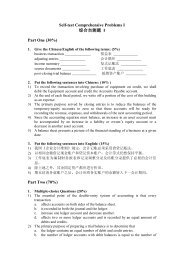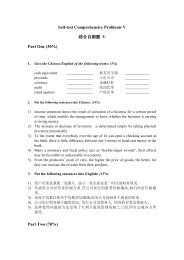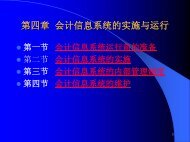Vodafone Group Plc Annual Report for the year ended 31 March 2012
Vodafone Group Plc Annual Report for the year ended 31 March 2012
Vodafone Group Plc Annual Report for the year ended 31 March 2012
You also want an ePaper? Increase the reach of your titles
YUMPU automatically turns print PDFs into web optimized ePapers that Google loves.
<strong>Vodafone</strong> <strong>Group</strong> <strong>Plc</strong><br />
<strong>Annual</strong> <strong>Report</strong> <strong>2012</strong> 102<br />
Notes to <strong>the</strong> consolidated financial statements (continued)<br />
2. Significant accounting policies (continued)<br />
Property, plant and equipment and finite lived intangible assets<br />
At each reporting period date, <strong>the</strong> <strong>Group</strong> reviews <strong>the</strong> carrying amounts of its property, plant and equipment and finite lived intangible assets to<br />
determine whe<strong>the</strong>r <strong>the</strong>re is any indication that those assets have suffered an impairment loss. If any such indication exists, <strong>the</strong> recoverable amount<br />
of <strong>the</strong> asset is estimated in order to determine <strong>the</strong> extent, if any, of <strong>the</strong> impairment loss. Where it is not possible to estimate <strong>the</strong> recoverable amount<br />
of an individual asset, <strong>the</strong> <strong>Group</strong> estimates <strong>the</strong> recoverable amount of <strong>the</strong> cash-generating unit to which <strong>the</strong> asset belongs.<br />
If <strong>the</strong> recoverable amount of an asset or cash-generating unit is estimated to be less than its carrying amount, <strong>the</strong> carrying amount of <strong>the</strong> asset or<br />
cash-generating unit is reduced to its recoverable amount. An impairment loss is recognised immediately in <strong>the</strong> income statement.<br />
Where an impairment loss subsequently reverses, <strong>the</strong> carrying amount of <strong>the</strong> asset or cash-generating unit is increased to <strong>the</strong> revised estimate of its<br />
recoverable amount, not to exceed <strong>the</strong> carrying amount that would have been determined had no impairment loss been recognised <strong>for</strong> <strong>the</strong> asset or<br />
cash-generating unit in prior <strong>year</strong>s. A reversal of an impairment loss is recognised immediately in <strong>the</strong> income statement.<br />
Revenue<br />
Revenue is recognised to <strong>the</strong> extent <strong>the</strong> <strong>Group</strong> has delivered goods or rendered services under an agreement, <strong>the</strong> amount of revenue can be<br />
measured reliably and it is probable that <strong>the</strong> economic benefits associated with <strong>the</strong> transaction will flow to <strong>the</strong> <strong>Group</strong>. Revenue is measured at <strong>the</strong><br />
fair value of <strong>the</strong> consideration received, exclusive of sales taxes and discounts.<br />
The <strong>Group</strong> principally obtains revenue from providing <strong>the</strong> following telecommunication services: access charges, airtime usage, messaging,<br />
interconnect fees, data services and in<strong>for</strong>mation provision, connection fees and equipment sales. Products and services may be sold separately or in<br />
bundled packages.<br />
Revenue <strong>for</strong> access charges, airtime usage and messaging by contract customers is recognised as services are per<strong>for</strong>med, with unbilled revenue<br />
resulting from services already provided accrued at <strong>the</strong> end of each period and unearned revenue from services to be provided in future periods<br />
deferred. Revenue from <strong>the</strong> sale of prepaid credit is deferred until such time as <strong>the</strong> customer uses <strong>the</strong> airtime, or <strong>the</strong> credit expires.<br />
Revenue from interconnect fees is recognised at <strong>the</strong> time <strong>the</strong> services are per<strong>for</strong>med.<br />
Revenue from data services and in<strong>for</strong>mation provision is recognised when <strong>the</strong> <strong>Group</strong> has per<strong>for</strong>med <strong>the</strong> related service and, depending on <strong>the</strong><br />
nature of <strong>the</strong> service, is recognised ei<strong>the</strong>r at <strong>the</strong> gross amount billed to <strong>the</strong> customer or <strong>the</strong> amount receivable by <strong>the</strong> <strong>Group</strong> as commission <strong>for</strong><br />
facilitating <strong>the</strong> service.<br />
Customer connection revenue is recognised toge<strong>the</strong>r with <strong>the</strong> related equipment revenue to <strong>the</strong> extent that <strong>the</strong> aggregate equipment and<br />
connection revenue does not exceed <strong>the</strong> fair value of <strong>the</strong> equipment delivered to <strong>the</strong> customer. Any customer connection revenue not recognised<br />
toge<strong>the</strong>r with related equipment revenue is deferred and recognised over <strong>the</strong> period in which services are expected to be provided to <strong>the</strong> customer.<br />
Revenue <strong>for</strong> device sales is recognised when <strong>the</strong> device is delivered to <strong>the</strong> end customer and <strong>the</strong> sale is considered complete. For device sales made<br />
to intermediaries, revenue is recognised if <strong>the</strong> significant risks associated with <strong>the</strong> device are transferred to <strong>the</strong> intermediary and <strong>the</strong> intermediary<br />
has no general right of return. If <strong>the</strong> significant risks are not transferred, revenue recognition is deferred until sale of <strong>the</strong> device to an end customer by<br />
<strong>the</strong> intermediary or <strong>the</strong> expiry of <strong>the</strong> right of return.<br />
In revenue arrangements including more than one deliverable, <strong>the</strong> arrangements are divided into separate units of accounting. Deliverables are<br />
considered separate units of accounting if <strong>the</strong> following two conditions are met: (1) <strong>the</strong> deliverable has value to <strong>the</strong> customer on a stand-alone basis<br />
and (2) <strong>the</strong>re is evidence of <strong>the</strong> fair value of <strong>the</strong> item. The arrangement consideration is allocated to each separate unit of accounting based on its<br />
relative fair value.<br />
Commissions<br />
Intermediaries are given cash incentives by <strong>the</strong> <strong>Group</strong> to connect new customers and upgrade existing customers.<br />
For intermediaries who do not purchase products and services from <strong>the</strong> <strong>Group</strong>, such cash incentives are accounted <strong>for</strong> as an expense. Such cash<br />
incentives to o<strong>the</strong>r intermediaries are also accounted <strong>for</strong> as an expense if:<br />
aa<br />
<strong>the</strong> <strong>Group</strong> receives an identifiable benefit in exchange <strong>for</strong> <strong>the</strong> cash incentive that is separable from sales transactions to that intermediary; and<br />
aa<br />
<strong>the</strong> <strong>Group</strong> can reliably estimate <strong>the</strong> fair value of that benefit.<br />
Cash incentives that do not meet <strong>the</strong>se criteria are recognised as a reduction of <strong>the</strong> related revenue.<br />
Inventory<br />
Inventory is stated at <strong>the</strong> lower of cost and net realisable value. Cost is determined on <strong>the</strong> basis of weighted average costs and comprises direct<br />
materials and, where applicable, direct labour costs and those overheads that have been incurred in bringing <strong>the</strong> inventories to <strong>the</strong>ir present location<br />
and condition.<br />
Leasing<br />
Leases are classified as finance leases whenever <strong>the</strong> terms of <strong>the</strong> lease transfer substantially all <strong>the</strong> risks and rewards of ownership of <strong>the</strong> asset to <strong>the</strong><br />
lessee. All o<strong>the</strong>r leases are classified as operating leases.<br />
Assets held under finance leases are recognised as assets of <strong>the</strong> <strong>Group</strong> at <strong>the</strong>ir fair value at <strong>the</strong> inception of <strong>the</strong> lease or, if lower, at <strong>the</strong> present value<br />
of <strong>the</strong> minimum lease payments as determined at <strong>the</strong> inception of <strong>the</strong> lease. The corresponding liability to <strong>the</strong> lessor is included in <strong>the</strong> statement of<br />
financial position as a finance lease obligation. Lease payments are apportioned between finance charges and reduction of <strong>the</strong> lease obligation so as<br />
to achieve a constant rate of interest on <strong>the</strong> remaining balance of <strong>the</strong> liability. Finance charges are recognised in <strong>the</strong> income statement.<br />
Rentals payable under operating leases are charged to <strong>the</strong> income statement on a straight-line basis over <strong>the</strong> term of <strong>the</strong> relevant lease. Benefits<br />
received and receivable as an incentive to enter into an operating lease are also spread on a straight-line basis over <strong>the</strong> lease term.






